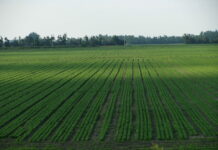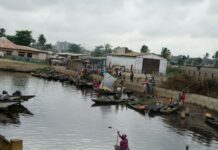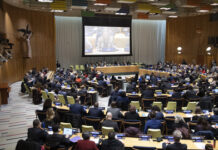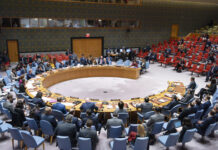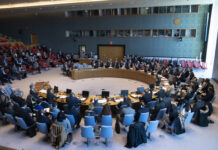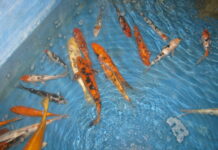Photo credit: DiasporaEngager (www.DiasporaEngager.com).
Excellencies, members of our Council, honoured guests, IOM colleagues and friends.
Today is the fifty-seventh day of my tenure as IOM’s Director General and my first Council meeting as the Director General. I just want to take a moment to acknowledge the extraordinary group of women you see now as the leadership of IOM. This is a historic moment, not just for me but for our Organization. I stand before you today deeply honoured to serve in this role. To lead what I believe is the most vital humanitarian organization in the world, dedicated to a topic that has become increasingly prominent in global discourse, migration.
We all know migration is as old as humanity itself. Throughout history people have migrated in search of better lives, fleeing conflict, fleeing persecution, or simply seeking new opportunities. And today migration is more complex and multifaceted than ever before. We are witnessing unprecedented migration, driven by globalization, economic disparities, climate change and political instability.
We estimate that today there are currently over 281 million international migrants worldwide, which represents 3.6 per cent of the global population. We know in today’s diverse environment, the movement of people has profound implications for both the sending and the receiving countries, and there is not a corner of the globe that is not touched by, or is in some way invested in, the issue of migration.
Esteemed members of the Council, we are here at a critical moment, and that moment is critical not just for IOM, but for the prosperity of the Global South for the development of the Global North, and for all our Member States, and most importantly, for the people themselves, for the people who have moved, who are going to move, or who will be on the move in the future.
At this critical moment let’s start with the facts, and let’s address how we ought to rethink the system, to make it fit for purpose so that together we can work more effectively for Member States and, most importantly, for the people, the migrants we serve.
To do that, I intend to lay out here three things for you:
- An assessment of the state of migration in the world today.
- Why our approach needs to evolve, and how IOM is positioned to do that
- Our plan for and need for resources to get the job done
If you read the headlines today, you would be forgiven for thinking that the sum total of migration challenges in the world today are on the shores of the Mediterranean or on the southwestern border of the United States. Now these areas do have significant concerns, and there have been meaningful increases in the number of migrants using irregular channels both to North America and to Europe, but the polarizing narratives that we’ve heard create a distorted picture that fails to capture the complexity of people who are on the move today.
So, let’s take stock for a moment. Away from the media headlines, the evidence is clear: most migration is geographically connected.
First, today more than 71 million people are internally displaced within the borders of their countries. Seventy-five per cent of those internally displaced persons are in just 10 countries.
For those who leave their country of origin, most of them stay in the region. For example, over 40 per cent of the world’s international migrants are from Asia, but over half of the migrants are living in another Asian country. In Africa, displacement due to conflict and climate change is playing a significant role, but most people are displaced within their own countries or in a neighboring country. In fact, most international migrants from Africa are moving to another African country. In Latin America, countries like Argentina, Colombia, Peru, Brazil, Chile are some of the main destination countries of both refugees and migrants within the region.
When we talk about international migrants, people who are moving throughout the world, two-thirds of them are directed related to work.
In fact, about 170 million people around the world are migrant workers, and nearly 87 per cent of them are in upper middle-income or high-income countries. Some of the largest migration corridors in the world are migrant workers from places like South Asia to Gulf countries, or from India to the United Arab Emirates, where 88 per cent of the population is foreign-born, or to Saudi Arabia.
Yet while high income countries attract the largest number of migrant workers, it is often low- and middle-income countries who are hosting those that are displaced due to conflict, disasters, climate change or other overwhelming pressures. Low and middle-income countries are hosting four-fifths of all the people who are displaced across national borders and the majority of people who are internally displaced.
While most migration is regular, safe and orderly, across the world, because of conflict, climate change, environmental degradation and uneven development, many people have little choice but to find safety and livelihoods elsewhere by moving.
To create a more humane and dignified response, there is more collectively that we must do.
Number one, we’re focused on saving lives. It’s clear that our most important work, the most fundamental work of this Organization is to save lives. It’s to address the pressures that drive people to migrate in the first place, and sometimes these drivers come without warning, putting people’s lives and futures at risk.
Our first objective, and I repeat this because it is so important, will always be to save lives. In 2023, we have responded to a huge number of crises, in fact we have eight what we call Level 3 responses. That means all hands are on deck to respond. Those eight are:
- Ethiopia
- Afghanistan
- Syrian Arab Republic and Türkiye, in response to the earthquake there
- Ukraine, where we have the biggest footprint of any UN agency
- Somalia
- Haiti
- The Democratic Republic of the Congo
- And in the Sudan, where today more than 8 million people have been displaced within and outside the country. That includes 4 million newly displaced people just since April.
That is eight “all hands-on deck” emergencies that we have had just this year. That’s a record number.
And we continue to remain on high alert to support communities in the Middle East. We are grateful today, as we all are, that there is a cease-fire at this moment and the release of some of the hostages. But we all know so much more needs to be done. All civilians must be released, and we must be able to provide life-saving support to civilians in Gaza.
The conditions there are truly a humanitarian catastrophe, and the people who are still there have virtually nothing resembling a safe or stable existence, enduring suffering beyond measure.
We know no one is going win in this conflict, but it’s clear that the most vulnerable are paying a price, including 108 of our UN brothers and sisters who have been killed there since early October. We have teams ready to provide support, but we have not been able to put them to work at the scale that is needed. We join the call of all our partners in the humanitarian world – let them do their job.
We’re proud of the work that we are able to do in emergencies. It’s not just providing humanitarian supplies and shelter – although we do that too. We collect data that supports other UN agencies around the world. In fact, 86 per cent of all humanitarian needs relied on IOM data coming out of our Displacement Tracking Matrix. And we are committed to doing more.
With your support, we will pre-position more stocks around the world so we can respond faster. We are increasing the money that we are setting aside to respond to fast-breaking humanitarian emergencies. We are going to build partnerships with the private sector to take advantage of their capacity to get aid out faster. But we know that if we only focus on humanitarian response, we will not be doing enough. Instead, we need to get smarter, we need to get more strategic, and more innovative, to build solutions by anticipating when people will be compelled to move.
That’s where our second objective comes in, driving solutions to displacement. That’s why any meaningful solution must look at all facets of the migration journey, not just supporting people who are already on the move, who are already displaced.
With more than 71 million people internally displaced within their borders of their countries, we know we need to start there, we need to build out solutions for people who are displaced within their communities. Particularly as climate change has a growing impact on vulnerable communities.
And we are seeing that while conflict has long been the biggest driver of protracted internal displacement, climate change now causes more new displacements than conflict. In 2022, nearly 33 million people were displaced because of floods, drought, heat, storms. This is the highest number in a decade. And no region of the world is immune. We must take urgent action now.
To make matters even more challenging, 80 per cent of internally displaced persons are now in countries that are highly vulnerable to climate change. Now, while we don’t know the exact number of displaced populations who will ultimately become international migrants, the estimate suggests that 20–30 per cent will eventually cross international borders.
They’re moving for a number of reasons: continued insecurity, violence in their countries of origin, lack of access to basic necessities and services and lack of employment or other livelihood opportunities. So we have to start by addressing those factors, the factors that contribute to someone’s decision to migrate. That’s why fully one quarter of IOM’s current budget is now going to support internally displaced communities around the world. That’s more than any other UN agency.
But it also means we need to build data into our response. That’s why last week in Berlin, I launched our new PROGRESS report, which is a data-driven, people-centered analysis of internally displaced communities – pulling information from 15 countries around the world that together have half of all the world’s IDPs.
It also means that we need to address the impact on the neighbouring countries. We need to work with communities who are at risk, we need to work with communities in place, we need to make sure that we are part of the solution, we need to do so in consultation with our UN partners around the world.
That’s why we are working closely with Robert Piper, who is the Secretary-General’s Special Adviser on Solutions to Internal Displacement, and his team, so that we are fully aligned.
It is not just about the communities themselves that are impacted, it’s about the communities they go to, and as I said, that is mostly communities in the neighbourhood. So we have to build support particularly when these countries are low- and middle-income countries, some of which are hosting the highest number of migrants in the world, and those that simply do not have the capacity to manage it on their own.
At the heart of what we do is data. There are all sorts of great statements about why data are important. One of my favourites is: if you are acting without data, it’s like standing in the middle of the highway without any signs or sense of where you are going. We are basically trying to figure out as things flash past us where to put our resources, where to put our time, where to put our money, and that is not a great way to act, ladies and gentlemen.
So that is why we are investing in data. It is not just the data about people who have already moved, although we do that very, very well. It’s really using data to understand why people are moving, to understand when communities feel the pressure to move.
We are seeing that most acutely when we are talking about climate change. Climate change is one of the places where we can start to forecast which communities do not have the resilience they need to respond to a changing environment.
So we are investing in our data and we are investing in partnerships – including as part of the United Nations Network on Migration – to forecast when communities will be at risk of displacement, and to build solutions to help them adapt and when adaptation is not possible, and that is true for many communities, to help them find solutions to move with dignity.
This was brought home to me just three weeks ago, where I had the honour to attend the Pacific Islands Forum. I was the first IOM Director General to attend the Forum’s Leaders Meeting, and it was absolutely amazing to see how leaders in that region are taking a proactive and constructive approach to address the impacts of climate change on communities that are going to be impacted.
They are building out a solution to address those communities most in need. Coming out of that meeting was a momentous Regional Framework on Climate Mobility. This Framework is going to provide practical guidance to governments and recognize the fundamental priority of people to stay in their ancestral homes. But at the same time, it’s pragmatic. It recognizes that some people will be forced to leave.
Also this month, coming out of that forum, Tuvalu, one of our Pacific Island Member States, and Australia signed a landmark agreement. That will facilitate regular migration pathways from Tuvalu to Australia.
Now, Excellencies, ladies and gentlemen, this forward-thinking, innovative solution, that is the kind of practice that we should replicate for communities who are at risk. It is not waiting until an entire nation has been absorbed by the sea in order to act. It’s recognizing the profound impact that climate will have on these communities and building out a pathway that is safe, that is regular, that is orderly and that ultimately will work for the nationals of Tuvalu as well as the nationals of Australia.
At the heart of our work, at the heart of agreements like the Regional Framework on Climate Mobility or the Kampala Declaration — which recognizes the impact of climate change on human mobility — is recognizing that well managed migration can often be a solution. It can be a solution to what would otherwise be displacement of communities in the hundreds of hundreds of thousands in the face of catastrophic shocks, like climate change.
The evidence shows overwhelmingly that long-term, regular pathways will better protect migrant rights, they will better enable governments to plan for and manage movements in an orderly way, and they will support economic development in the countries that the migrants are coming from, as well as the countries that migrants are going to.
Now, ultimately, it is up to all of you, it’s up to you as governments to create the policies that will enable those regular pathways. We are so excited about the work that we are seeing in that space, including with the European Union’s Talent Pool and the Safe Mobility Offices across the Americas.
IOM is well positioned to do the work, to facilitate these pathways, and together with our sister UN agencies, we can build outcomes that will have tremendous benefit. We can reduce burdens on asylum systems to help safeguard international refugee protections. We can tackle the smuggling and trafficking business model, which, by the way, is a 10 billion, that’s 10 billion dollar business. We can tackle it head on by reducing the market for intermediaries. We can protect migrant lives and we can decrease the exploitation of vulnerable people.
Over the last year, more than 5,300 migrants have lost their lives. Those are only the ones we know of. The number could actually be higher. And, together, by creating more regular pathways, we can increase public confidence that migration is well-managed, not chaotic, and that most importantly we can together contribute to the development of the migrant herself, the country that is hosting her and the country she is coming from.
Now, I am using “she” deliberately because we know that a key component of facilitating regular pathways involves helping women and girls. We know, for example, that women migrant workers send a greater share of their wages back to their countries of origin than their male counterparts do — sorry guys — driving human development in their communities.
That’s why IOM is launching the gender and migration research lab. or GenMig, which is focused on building opportunities for women, by enabling women as drivers of change, not just as victims of exploitation.
We are also working with partners, like Talent Beyond Boundaries and the private sector, to identify the skilled displaced talents in places like Jordan and Lebanon and to connect them to employers in places like Belgium or Ireland, Portugal or the United Kingdom. Now this type of skilled mobility pathway is driven by the employers themselves. It not only brings the skills that the employers are looking for, it also brings unique perspectives, diverse experiences, and highly motivated workers.
And Excellencies, ladies and gentlemen, this is only the beginning. If we are going to have a significant impact, we need to scale up, we need to match our efforts to the existing migration patterns, for example by advancing the African Union’s 2063 Agenda to enable the free movement of trade and of people.
We also know that the demand for migrant workers is only going to grow. In fact, 30 of the world’s largest economies have labour shortages, and the cost of unfilled jobs was over 1.3 trillion dollars. Demographic changes are also going to drive the need for more international migration. By 2050, people over the age of 65 will represent nearly 40 per cent of populations in Japan and the Republic of Korea. Italy, Spain, Greece, and Portugal are not far behind.
Now there is good news for you as well, on the flip side of the demographic equation, the world now has the largest youth generation in history: 1.8 billion people between the ages of 10 and 24, and most are living in developing countries.
Unfortunately, there are not enough jobs where they live to provide formal work for all of the young people who now exist. But that’s why finding regular pathways to enable better managed migration is so key, because in many parts of the world a growing number of young people is a massive demographic dividend.
In Africa, it’s been dubbed as a “youthquake,” as young Africans are expected to make up 42 per cent of the world’s young people by the end of this decade. The promise for Africa is immense, especially if we can develop regular migration flows and increase investment in human capital and in job creation.
There is another part of the story that we don’t tell often enough, and that is the impact of migrants on the economies of the countries that they are coming from. Our estimates show that international remittances are now at about 830 billion dollars, up from 130 billion dollars in the year 2000. That’s 830 billion, with a b, which is more than direct foreign investment and far more than official development assistance.
At a moment in time when members around the world are telling us how stretched they are, that they do not have the resources they need to meet the scale of conflict and climate change and displacement, it just makes sense, ladies and gentlemen: let’s leverage the power of migration.
Migrant workers and a diaspora are feeding, they are housing, they are educating their families, and they are supporting their communities, their regions and their countries all from afar. And for the countries of origin, migration is fostering broader economic and social development. Through trade, migration is fostering the two-way transfer of skills, knowledge, innovation and technology. And for those countries that are poorer or fragile, it can help with peacebuilding and post-conflict resolution and recovery.
Let’s take some of the lessons from my favourite publication of 2023, the World Bank’s 2023 Development Report, and let’s do a couple of things: let’s maximize net gains for all people by identifying the people whose skills and attributes strongly match the needs of the destination countries; let’s recognize that this does not mean all high-skilled, highly educated workers; and let’s reduce the need for distressed movements, while respecting the human rights and the human dignity of all people. We will recognize development’s key role in this effort, meaning that we will build on programmes that connect especially vulnerable migrants to regular pathways. Let us manage migration strategically, in both the origin and destination countries. That means the governments in origin countries should make labour migration an explicit part of their development strategies, while the governments in the destination countries should use matching migration to meet their labour needs.
Now as you can hear, we have an ambitious agenda. That is why IOM must be fit for purpose if we hope to achieve any of this. That means we need to address the issues we are seeing emerge, we need to make sure that we enable our workforce to do what it can do best, to make sure they can reach people in need and do so in a timely, effective and compliant manner.
That means we need to make some investments. We need to invest in IOM as an institution itself. We need to invest in our workforce and partnerships within and outside the UN community. We need to invest in communications and in internal systems.
Overall, the 2024 budget allocates new resources to some key components of our institutional structure: finance, legal, human resources, our regional offices, and cybersecurity. We are making progress, but we know we still have some room to grow. We have more work to do. And, Excellencies, we are going to continue to need your engagement, we are going to need your help in ensuring that we have the budgetary and strategic processes that match the size and scale of our operations.
We will continue the ongoing discussions with you about the independent analysis that we are getting on our structure, and we hope that the review of our Headquarters structure will be done by early next year. The review of our field structure, of our regional offices, of how IOM delivers work around the world will be ongoing, and that’s a conversation that we want to have with you. We want to be sure that we are matching the size and scale of our organization to the needs that exist.
We share with you, Member States, the objective of ensuring that our resources are being well utilized. We will share with you what we are learning through our own assessments and seek your guidance on the way forward.
Recent external assessments, like the MOPAN, like that done by the Australian Government and the UK Government, have been key. Frankly, they provide a road map for us as an organization to make sure that we are meeting your expectations, and that we are doing so transparently, that we are doing so efficiently and that we are having impact on the ground.
We know that in the world today, we need to anticipate and respond to multiple crises all over the world. It is critical that we not just respond but that we anticipate and get out ahead of them.
To put it one way, when the roof is leaking it can be quite effective to put buckets out to catch the rain, and one can be quite agile with a bucket, and one can be very non-bureaucratic when putting out those buckets. But we want to move from just putting out buckets in the midst of the rainstorm. We need to do work to fix our structure. We need to do work to repair the roof, and that is why we are asking for your support.
Now I want to do something that I did at the Standing Committee on Programme and Finance, which is to call out those States who are providing flexible unearmarked support to our Organization, to recognize Austria, Belgium, Denmark, France, Ireland, the Republic of Korea, the Kingdom of the Netherlands, Norway, the Philippines, Qatar, Spain, Sweden, Switzerland, the United Kingdom, and the United States of America.
Now I call out these countries, because these countries are all providing unearmarked contributions to IOM. And the contributions allow us to be efficient, to be agile, to ensure that we are continuing with our highly projectized model, but to do so without sacrificing what we know you are demanding from us, accountability and efficiency.
Excellencies, members of our Council, friends and colleagues, we know what a precarious situation the world is in today. Recent events have reminded all of us of the true value of this multilateral community to which we belong. The true value of international organizations who can step up when no one else is stepping up, who can respond when conflict or disaster strikes, who can protect the world’s most vulnerable, and save lives when there is no one else to save them.
It is those organizations that have the greatest potential to help people with widely different viewpoints ultimately come together to find a common goal: to be able to see everyone have the chance to flourish, peacefully and safely.
Ladies and gentlemen, Excellencies, we all need each other, and, speaking personally, I need you. I need your wisdom, I need your experience. I thank you for the advice and counsel that you’ve given me, that you’ve given to this Organization, and I personally am grateful for the support that you have shown to the people of IOM. It is absolutely my privilege to be their leader. Thank you to them, and to you, for all that we are doing together to make this world a better place.
Thanks very much.
Download the Statement
Source of original article: International Organization for Migration (www.iom.int).
The content of this article does not necessarily reflect the views or opinion of Global Diaspora News (www.GlobalDiasporaNews.com).
To submit your press release: (https://www.GlobalDiasporaNews.com/pr).
To advertise on Global Diaspora News: (www.GlobalDiasporaNews.com/ads).
Sign up to Global Diaspora News newsletter (https://www.GlobalDiasporaNews.com/newsletter/) to start receiving updates and opportunities directly in your email inbox for free.





